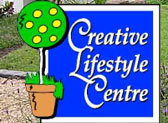









Newsletter
Please Email us at gltaylor@iafrica.com if you are interested to receive our newsletter. |
||
Kay Montgomery from SA Garden interviews Glenda Taylor Glenda Taylor is a garden designer and owner of Creative Lifestyle Garden Centre in East London where she lives and works. I visited her to take photographs of some of the many gardens that she has landscaped. Kay: What qualities set a talented designer apart from their contemporaries? Glenda: Horticultural knowledge is important, however one can never learn all there is to know about plants in a lifetime. An awareness of geographical factors, architectural styles and knowledge of building science is necessary. Communication, drawing skills, business skills and experience are also important. Skilled artisans and trained landscaping staff are required. Then, one needs to combine all this with a strong artistic and problem solving ability. I suppose hereditary genes also play a role – my fathers side of the family were involved in the construction industry while my mothers side grew flowers, veggies, fruit…. Kay: Some people are daunted by the prospect of redesigning their garden because even when you're dealing with a small space it does cost money. Glenda: Yes, especially if new hard landscaping is involved. But the point about having a professionally designed garden is that you can do as much or as little of the work as you can afford at a time and you can be secure in the knowledge that when it is finally finished – whether that's in two years or ten – you will have a lovely garden that works as a satisfying whole and in turn adds tremendous value to your property and lifestyle. Kay: Where do you get your inspiration? Nature. Books. BBC garden makeovers. I enjoy studying garden plans of renowned designers. John Brookes is my mentor and I was amused that you recognized his influence in my work – that is a great honour. There is a timeless quality about his work –an understated style with a strong emphasis on using indigenous plants to blend the garden into its natural surrounds. Dairmund Gavin's work is also inspiring and I have recently completed a modern pool area using stainless steel materials, purple walls, glass panels, timber decking, a stone river bed and colourful lights. I also visited the Royal Hampton Flower Show 2004 and visited many of the great gardens in England. So many South African plants take pride of place in the English summer perennial borders– kniphofia, dierama, melianthus major, agapanthus, diasica, nemesia, tulbaghia, crinium lily, restios, buddleja salvifolia …….. Kay: What is your favourite garden around the world? That is so hard to say. Sissinghurst in Kent, for its history and architecture. There are actually ten different gardens separated by existing buildings, walls, yew hedges and a moat. For the visitor there is always the expectation that there is a lot more to find and then the surprise of finding it. The Eastern Cape also has so many natural treasures. I was amazed at the natural flora at Trennenarys along the Wild coast. Masses of aristea ecklonii and arum lily grow under groves of waterbessie trees. A boat ride up the river revealed the most natural botanical garden I have ever visited – crassula, plectranthus, cyads, ferns, grasses and so many different indigenous trees. On a recent garden tour to the Baviaans River Valley near Bedford, we were in awe at the vast array of natural flora – chinkerinchee, aloe striata, euphorbia, bulbine, brightly coloured vygies – all surviving happily in the harshest environment. Few areas can compare with the Pirie Forests near Stutterheim – Hogsback . Cape Chestnut, Cape beech, White stinkwood, Forest elder, real yellowwood and the Outeniqua yellowwood form a dense canopy in this beautiful indigenous forest. Kay: What is your favourite plant and why? My answer to this question usually depends on when in the year I am asked, and since it is summer I would say that salvias are among my favourite flowers. They stand up to the heat and humidity and Salvia ‘Victoria blue' looks like lavender from a distance. S.' black blue' look equally good in a lush tropical garden or herbasceous perennial border. Add a leaf and red flower sprig of S.'elegans' to a cold glass of water for a gentle pineapple flavour. S. uliginosa – bog sage, with tiny sky blue and white flowers soften the margins of ponds. S. rosakoning and S.farnacea white bask happily in the sun. S. leucantha “mexican sage” flowers from spring to autumn. Plant salvia next to daylilies for a superb contrast in leaf, texture and colour. Among the indigenous salvia that I like are: S. lutea, S. dolomitica, S. muirii (almost extinct in nature) and S. chaelaeagnea. Kay: Any dreams? Yes, to develop a botanical garden of note in East London that will educate people about the wonderful world of plants and their uses and to attract visitors from all over the world to our undiscovered province. |
For more info, please e-mail gltaylor@iafrica.com